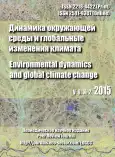Sarcosoma globosum is a care-demanding fungus on the KhMAO Red Data Book. It is global rare and vulnerable also, and was proposed for inclusion in the Habitat Directive Appendices of the Bern Convention. The purpose of our nine-year study was an investigation of typical habitats, fruiting frequency, biology and phenology of this species in the middle taiga zone of Western Siberia. Since 2006 the territory about 1 million hectares was surveyed by route method. The vegetation of each population locality was described according standard geo-botanical procedure. Fruit bodies were counted. Location of fruit bodies inside the population was plotted in a chart. In 2013 we visited two populations four times per season to observe the development of fruiting bodies. The total number of the encountered localities was 29. S. globosum was found in both types of landscape: swamped and well drained ones. In swamps it preferred raised places along tree roots and moss-covered trunks. The wet sites inhabited by this species are mostly brook forests dominated by Pinus sibirica, Picea obovata, and Abies sibirica . Well-drained sites are aspen forests or dark coniferous mixed forests ( Pinus sibirica, Picea obovata, Abies sibirica, Populus tremula, Betula pendula ) with feather-mosses, low shrubs and forbs in the ground cover. Both types of habitats are old, species-rich and characterized by growing on nutrient-rich soil. Fruit bodies of Sarcosoma usually grew in groups (2 - 23) or sometimes solitary. The number of groups reached 17 per locality. The biggest population gave 138 fruit bodies. Area of the investigated populations ranged from 10 cm 2 to 3859m 2. During the survey, some special features of fructification were observed. All apothecia appear almost simultaneously by the end of May. This time they are globe-shaped with an underdeveloped disk and dense gel inside. By the middle of June, apothecia are full-grown, surface is wrinkled, and content becomes liquid. In late June, disk edges become flat and wavy. The disk disappears by the middle of July, and the remains of apothecia plunge into the litter. S. globosum fruits once per year. Life of apothecia takes about 1.5 month. During 9 years, sporocarps appeared sporadically. The springs of 2008 and 2013 were good for fruiting of Sarcosoma . We have found 11 and 12 localities with fruiting Sarcosoma respectively. In 2006, 2007 and 2014 number of sites found was 2-3 per season. During the period of 2009 - 2012, fruit bodies were not met. Weather condition required for fruiting are ambiguous and discussed in present paper. The species shown high sensitivity to environmental conditions, so it can be useful as an indicator of specific habitat quality.
 3-11
3-11


 12-16
12-16


 17-20
17-20


 21-33
21-33


 34-43
34-43


 44-54
44-54










